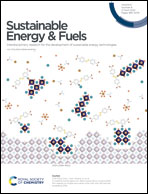Sequential and simultaneous ion transfer into carbon nanopores during charge–discharge cycles in electrical double layer capacitors†
Abstract
Electrical double layer capacitors (EDLCs) exhibit high potential, high power density, and fast charge–discharge. EDLC systems are useful sustainable energy technology. Although high capacitance can be achieved in the subnanometer pores of carbon electrodes, ion dynamics related to capacitance is still not well understood. Here, we demonstrate the mechanism of ion dynamics associated with EDLCs by molecular dynamics (MD) simulations and experimental approaches. Moreover, capacitance increased with a decreasing pore width, both experimentally and in the simulation, whereas only the experimental capacitance showed a maximum at the 2 nm pore, which was caused by the complex pore structure of activated carbons. A decreased capacitance was experimentally observed due to the formation of amorphous compounds on carbon electrodes via the degradation of ions, solvents, and electrodes during repetitive charge–discharge cycles. MD simulations showing no degradation of the electrolyte or the carbon electrodes presume that the decreased capacitance stems from the existence of idle ions through ion pair formation. Simultaneously, the fast relaxation time of capacitance and slow diffusion in wide pores were observed, which indicated fast charge–discharge with slow ion dynamics in wide pores. The anomalous feature is a result of the ion charge and release from carbon interfaces occurring in wide carbon pores. Furthermore, MD simulations propose that 1.5–3.0 nm pores are capable of both high capacitance and fast relaxation time.



 Please wait while we load your content...
Please wait while we load your content...